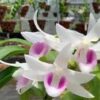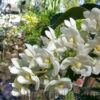# Techniques for Pollinating Dendrobium Anosmum: A Comprehensive Guide

Dendrobium anosmum, commonly known as Đai Châu or the fragrant orchid, is a stunning epiphytic orchid native to Southeast Asia. Renowned for its beautiful flowers and sweet scent, this orchid holds significant cultural and economic value in Vietnam and beyond. One of the key practices in orchid cultivation is pollination, which is essential for producing seeds and facilitating the propagation of new plants. This article delves into the techniques for pollinating Dendrobium anosmum, discussing various methods, best practices, and the importance of pollination in orchid cultivation.
## Understanding Orchid Pollination
### The Biology of Orchid Pollination
Orchids are unique in their reproductive strategies. They typically possess both male (anthers) and female (stigmas) reproductive structures, which are housed in a complex flower structure. Pollination occurs when pollen from the male part is transferred to the female part, resulting in fertilization. This process can occur naturally through the actions of pollinators such as bees, butterflies, and hummingbirds, or it can be facilitated by human intervention through artificial pollination techniques.
### Importance of Pollination
Pollination is crucial for several reasons:
– **Seed Production**: Successful pollination leads to the formation of seeds, which can be used to grow new plants. This is particularly important for maintaining and expanding orchid collections.
– **Genetic Diversity**: Cross-pollination between different plants can introduce new genetic material, promoting diversity within the species and enhancing resilience to diseases and environmental changes.
– **Commercial Value**: Many orchid enthusiasts and collectors seek out seeds and hybrid plants. Effective pollination techniques can increase the yield and quality of seeds, making them more desirable in the market.
## Preparing for Pollination
### Selecting Parent Plants
Before pollination can occur, it’s essential to select healthy parent plants. When choosing Dendrobium anosmum plants for pollination, consider the following factors:
– **Health and Vigor**: Look for plants that exhibit robust growth, healthy leaves, and vibrant flowers.
– **Flower Characteristics**: Choose flowers with desirable traits, such as color, size, fragrance, and bloom duration. This is particularly important if you are aiming to produce specific hybrids.
– **Genetic Diversity**: If possible, select plants from different genetic backgrounds to promote diversity in the resulting seeds.
### Timing the Pollination
Timing is crucial for successful pollination. Dendrobium anosmum typically blooms in late winter to early spring, depending on the climate. The flowers usually last for a few weeks, and the ideal time for pollination is during the peak bloom when the flowers are fully open and receptive.
### Tools and Equipment
Having the right tools on hand will facilitate the pollination process. Essential tools include:
– **Tweezers or Fine Brushes**: For gently transferring pollen.
– **Petri Dishes or Small Containers**: For collecting and storing pollen.
– **Labeling Materials**: To keep track of the parent plants and the date of pollination.
– **Sterilization Supplies**: Such as alcohol wipes, to ensure tools remain free of contaminants.
## Techniques for Pollinating Dendrobium Anosmum
### 1. Natural Pollination
Natural pollination can occur if there are suitable pollinators nearby. However, relying solely on this method may not always yield desired results, particularly in cultivated environments. Nevertheless, understanding how natural pollination occurs can help inform your practices.
**Process**:
– **Attract Pollinators**: Ensure the growing area is conducive to attracting pollinators. This may involve planting companion flowers that are known to attract bees or butterflies.
– **Observe Pollinators**: Watch for the activity of pollinators visiting the orchids. Natural pollination can be more successful if multiple orchids bloom simultaneously, increasing the chances of attracting pollinators.
### 2. Hand Pollination
Hand pollination is the most reliable method for ensuring successful fertilization in Dendrobium anosmum. This technique allows for targeted cross-pollination between specific parent plants.
**Steps for Hand Pollination**:
**a. Collecting Pollen**:
1. **Identify the Male Structure**: Locate the anther, which contains the pollen. In Dendrobium anosmum, the anther is typically located at the top of the column, hidden beneath the petals.
2. **Use a Tool**: Carefully use tweezers or a fine brush to collect the pollen from the anther. Be gentle to avoid damaging the flower.
**b. Transferring Pollen**:
1. **Identify the Female Structure**: Locate the stigma, which is the receptive part of the flower, usually positioned at the tip of the column.
2. **Apply the Pollen**: Gently touch the collected pollen onto the stigma using the same tool. Ensure that the pollen makes contact with the stigma to facilitate fertilization.
**c. Repeat for Multiple Flowers**: If desired, repeat this process with different parent plants to create hybrid seeds.
### 3. Cross-Pollination
Cross-pollination involves transferring pollen from one plant to the stigma of another. This method is essential for creating hybrids and enhancing genetic diversity.
**Steps for Cross-Pollination**:
1. **Choose Two Parent Plants**: Select two different Dendrobium anosmum plants that exhibit desirable traits.
2. **Collect Pollen from One Parent**: Follow the steps for collecting pollen as described in the hand pollination section.
3. **Transfer Pollen to the Other Parent**: Apply the pollen to the stigma of the second parent plant, ensuring good contact.
4. **Label the Cross-Pollination**: Clearly label the cross-pollination attempt with the parent plant names and the date for future reference.
### 4. Self-Pollination
Self-pollination occurs when pollen from the same flower is transferred to its stigma. While this method may not promote genetic diversity, it can still result in successful seed production.
**Steps for Self-Pollination**:
1. **Identify the Flower**: Select a flower that is fully open and ready for self-pollination.
2. **Collect Pollen**: Use tweezers or a fine brush to collect pollen from the anther.
3. **Transfer to the Stigma**: Gently place the pollen onto the stigma of the same flower.
4. **Monitor for Seed Development**: After a successful self-pollination, monitor the flower for signs of seed pod development.
## Post-Pollination Care
### Maintaining Optimal Conditions
After pollination, it is crucial to provide the right conditions to ensure the successful development of seed pods:
– **Temperature and Humidity**: Maintain consistent temperature and humidity levels to support seed development. Dendrobium anosmum thrives in warm, humid conditions.
– **Watering**: Water the plants regularly, ensuring that the potting medium remains moist but not waterlogged. Overwatering can lead to root rot and other issues.
### Monitoring Seed Pod Development
Once pollination is successful, the flower will begin to form a seed pod. This process can take several months, and it is essential to monitor the pod’s development:
– **Signs of Maturation**: Seed pods will gradually increase in size and change color as they mature. They typically start green and may turn yellow or brown when ready for harvesting.
– **Avoiding Pests and Diseases**: Keep an eye out for pests and diseases that may affect the developing seed pod. Implement pest control measures as needed to protect the plant.
### Harvesting Seeds
When the seed pod has matured, it is time to harvest the seeds. This process is critical to ensure that the seeds are collected at the right time for optimal germination.
1. **Timing the Harvest**: Harvest the seed pods when they are brown and dry but before they split open. This is usually a few months after successful pollination.
2. **Collecting the Seeds**: Carefully cut the seed pod from the plant and place it in a dry, well-ventilated area. Once the pod has dried, it may split open, releasing the seeds. Collect the seeds using tweezers or a small brush.
3. **Storing the Seeds**: Store the collected seeds in a cool, dry place until you are ready to plant them. Use labeled envelopes or small containers to keep track of the seed varieties.
## Challenges in Pollination
### Environmental Factors
Several environmental factors can affect the success of pollination:
– **Temperature Fluctuations**: Extreme temperature changes can stress the plants and affect their reproductive capabilities.
– **Humidity Levels**: Low humidity can hinder pollination and seed development, while excessively high humidity may promote fungal diseases.
### Pests and Diseases
Pests and diseases can significantly impact pollination efforts:
– **Orchid Pests**: Common pests such as aphids, spider mites, and mealybugs can damage flowers and reduce their viability for pollination.
– **Fungal Infections**: Fungal diseases can affect the health of the flowers, making them less receptive to pollination.
### Knowledge and Experience
Successful pollination requires knowledge and experience:
– **Understanding Orchid Biology**: Growers must be familiar with the reproductive structures and timing of Dendrobium anosmum to achieve effective pollination.
– **Practice**: Gaining experience in hand pollination and observing the results can enhance the likelihood of success in future attempts.
## Conclusion
Pollination is a critical aspect of cultivating Dendrobium anosmum, enabling the production of seeds and the development of new hybrids. Through techniques such as hand pollination, cross-pollination, and self-pollination, growers can effectively facilitate the reproductive process and enhance the genetic diversity of their orchid collections.
By understanding the biology of orchid pollination, selecting the right parent plants, and providing optimal care post-pollination, growers can successfully navigate the challenges of this

